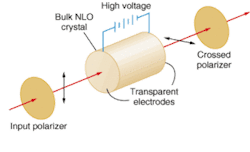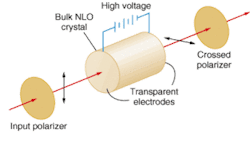Modulation in all things
All methods of communication rely on modulating a signal. Optical telecommunications for example would be impossible without a means of modulating laser-diode sources. There are a variety of ways to produce controlled variations in the amplitude, frequency, or phase of a light signal. Control of the fastest signals often relies on electro-optic effects, which have their basis in nonlinear optics (NLO).
Material benefits
Historically, the two NLO effects that have been most commonly used for electro-optic (E-O) modulation are the Pockels effect, a second-order NLO phenomenon, and the Kerr effect, a third-order response. In both cases, birefringence is produced in an NLO material in response to an externally applied electric field. The magnitude of the birefringence in the Pockels effect varies linearly with the applied field, while the Kerr effect changes in proportion to the square of the applied field.
By and large, the same crystalline materials used for second-harmonic generation are also used to produce the Pockels effect. Such second-order NLO materials must lack a type of symmetry in their crystalline structure—that is, they must be noncentrosymmetric. Materials widely used in Pockels-effect devices include deuterated potassium dihydrogen phosphate (KD*P), potassium tantalate niobate (KTN), and barium titanate (BaTiOg). Lithium niobate (LiNbO3) has found wide application in electro-optic applications for telecommunications.
The Kerr effect can occur in these crystals as well, but unlike the Pockels effect, the Kerr effect (as with all third-order effects) can take place in isotropic materials. The Kerr effect was first discovered in glass by the 19th century eponymous Scottish physicist. Practical devices that rely on the Kerr effect have been made using liquids such as nitrotoluene and nitrobenzene. By comparison, Pockels-effect devices have grown greatly in importance as the quality of NLO crystals has improved.
Inducing a response
The use of nonlinear optical materials to modulate a beam relies on the effect these materials have on the beam polarization. With no external electric field applied, a crystal such as KD*P will transmit a beam directed along its optic axis with no change in the polarization state. Applying an electric field to the KD*P crystal, however, will induce a birefringence in the material that is proportional to the applied voltage (typically several kilovolts in bulk crystals).
Second-order nonlinear phenomenon combine two beams in a material, as expressed by
χ(2)E1cos(ω1t) E2cos(ω2t)
where χ(2) is the second-order susceptibility. The applied DC field can be thought of as an incident beam of zero frequency. So, for the Pockels effect, two fields—the incident beam and the applied field—are combined in the material to produce an output beam of the same frequency.
The polarization changes are described by the tensor properties of the susceptibility. These relate the polarization state of the input and output beams to the structure and orientation of the crystal. The same concepts apply to the third-order Kerr effect, except now two of three incident fields are zero-frequency DC fields (hence the quadratic dependence on applied voltage).
Good to be extinct
If the electrodes used for the applied voltage are made of a transparent compound (typically based on tin oxide) and coated on the ends of the crystal, the resulting device is called a longitudinal E-O modulator. In this case the magnitude of the Pockels effect is independent of the dimensions of the crystal. The electrodes can also be placed across the direction of propagation to form a transverse E-O modulator.
For transverse E-O modulators, the phase retardation is proportional to the crystal length as well as the applied field. Because of this added dependence on crystal length, transverse E-O modulators can be constructed that require only low voltages, which can be modulated more rapidly. Miniature E-O modulators for telecom using LiNbO3 may require only a few volts. In addition, the transverse electrodes do not interfere with the beam.
An important measure of the performance of a modulator is its extinction ratio, the ratio of the signal level when the modulator is fully transmitting divided by the signal that leaks through when the device is fully closed. Commercial E-O modulators have extinction ratios that exceed 1000. Transverse E-O modulators tend to have lower extinction ratios than longitudinal modulators.
Assembling a modulator
To use the Pockels effect to produce amplitude modulation, a crystal of, say, KD*P is placed between two polarizers that have their transmission axes oriented at right angles to each other. Such a device is called a Pockels cell (see Fig. 1). With no voltage applied to the crystal, the linearly polarized beam passed through the KD*P is unchanged and is absorbed by the crossed polarizer. However, when a voltage is applied, the KD*P becomes birefringent and changes the polarization of the transmitted beam.
In this condition, the KD*P divides the polarized light from the first polarizer into two components that travel through the crystal at different speeds. The polarization state of the beam when it exits the crystal depends on the phase difference between the two orthogonally polarized components, which depends on the applied voltage. At the half-wave applied voltage, the light wave exits the KD*P linearly polarized and perpendicular to its incident polarization. The Pockels cell then acts as an open shutter because the polarization of the beam has been rotated to be parallel to the second polarizer.
If the one-quarter-wave voltage is applied, the beam will exit the KD*P circularly polarized. At the quarter-wave voltage, only half of the light makes it through the second polarizer. So, by varying the applied voltage, this particular configuration of the Pockels cell functions as an amplitude modulator. The Pockels cell has no moving parts, and is capable of amplitude modulation at tens of gigahertz.
Widespread use
Other combinations of polarizers and the Pockels effect in NLO crystals are also referred to as Pockels cells, and are used to produce frequency or phase modulation as well. The same general principals apply to the Kerr effect, which as mentioned above, can be used with a much wider variety of materials. Because the Kerr effect is proportional to the square of the applied field, it is also referred to as the quadratic electro-optic effect.
Although the Kerr effect increases quadratically with the applied field, nevertheless the small size of the coefficients for practical materials results in the need for applied voltages more or less around 30 kV. The response time of a Kerr cell can be 10 GHz or greater. Because Kerr cells can use a variety of materials, they can be made very robust to optical damage from high-power beams.
Changing the direction of a beam can also be thought of as a form of modulation. Electro-optic devices are used to direct laser beams, particularly in applications in which an acousto-optic modulator (AOM) has difficulty in holding off higher powers. Electro-optic devices serve the same function as AOMs for Q-switching and active modelocking, for instance. As a particular example, Pockels cells are used to select and retain high-peak-power pulses from a modelocked Ti:sapphire laser for chirped pulse amplification (see Fig. 2).
Next-generation promise
The development of the all-optical network in telecommunications is widely anticipated. Critical to its deployment is the development of all-optical switches to avoid the bottleneck that occurs when optical beams are converted to electrical currents to be routed and otherwise processed. Waveguide switches, which commonly rely on the Pockels effect, are competing with other promising technologies for this all-optical application.
A waveguide switch divides a signal into two fiberoptic paths, one of which is made of lithium niobate, and so can be made to delay its half of the signal relative to the other half using induced birefringence. When the paths and the signal are brought back together, the signal amplitude of the recombined beam depends on the relative phase of the two components. The initial level can be used as a control indicator to determine the next path for routing the signal
This E-O switch is among the fastest all-optical switching devices, and is highly reliable. This simplified description is an example of a type of device known as a Mach-Zehnder interferometer (MZI). Signal modulation for telecom applications is performed by external modulators such as MZIs because directly modulating the output of a laser diode by varying its current will alter its wavelength.
Plastic in the lab
It might be surprising to hear that polymers are under investigation as alternative NLO materials for MZIs and similar devices (see Fig. 3). Historically, polymers have a (well-deserved) reputation for poor optical quality. In recent years however polymers have been developed that match or exceed the transparency of silica.
State-of-the-art polymers are particularly attractive for integrated optics because they can be made quickly and inexpensively. Polymers used in integrated optics include such familiar materials as acrylates and polycarbonates. The polymer is impregnated with a chromophore and is then electrically poled to orient the chromophore molecules.
Some polymer formulations have exhibited the largest electro-optic coefficient achieved in any material. There have, however been difficulties with the stability of these materials, and the index of refraction of the end product is typically very sensitive to temperature. Hybrid designs that combine polymers with more traditional NLO materials to circumvent these difficulties are in advanced stages of development.
Next month's article begins the discussion of stimulated scattering.
Correction
The May Back to Basics article on higher harmonics stated: Gigawatt peak powers (10-mJ pulses with a duration of 10 ns) with good beam quality can be converted with 30% efficiency to the third harmonic and 10% efficiency to the fourth harmonic. The sentence should have referred to Gigawatt-per-cm2 peak powers.



